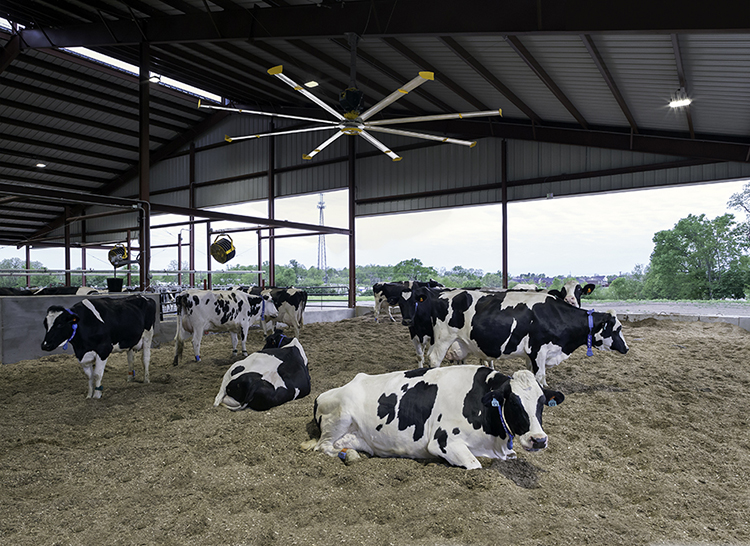
Heat stress is back for the summer.
The most important tool to deal with rising temperatures is airflow, according to John Tyson of Penn State Extension. “All other heat abatement methods are limited by poor air exchange,” he emphasized.
Tyson and Dan McFarland discussed methods to cool dairy barns in a Penn State Extension webinar titled “Finding and Addressing Dairy Facility Bottlenecks.”
Temperature matters
First, we must identify our goals for cooling. Although a cow’s thermal neutral zone (those temperatures at which she will expend minimal energy regulating temperature) can reach 77°F, the optimal thermal comfort zone is between 30°F and 70°F, Tyson said.
Taking humidity into account, dairy cows will begin experiencing heat stress when the temperature humidity index (THI) is above 72. High-producing cows may be stressed as early as 68 THI.
An estimate of THI can be made based on the average temperature. In dry climates, average THI is generally five to six units lower than the average temperature. THI in humid climates will average two to three units lower than the temperature reading. Any time relative humidity is less than 100%, there will be some amount subtracted from the "dry bulb" temperature.
Checking rectal temperatures can be a useful gauge in identifying heat stress. If 10 cows are tested on a hot day and at least eight read above 102.5°F, the group is in need of heat abatement.
Longer-term heat stress may be evidenced by drops of up to 10% in dry matter intake and milk production.
Moving air out
Providing shade is the first, immediate step to reduce body temperature. Next comes stimulating fresh airflow into the barn and removing warm, moist air.
“Air exchange is going to happen because of the sidewall openings and because of the ridge opening,” Tyson explained.
McFarland identified standards for both openings. Sidewall openings should provide 11 square feet of air entry per cow, and a ridge opening should be at least 2 inches for every 10 feet of building width. McFarland detailed how to determine a barn’s natural ventilation factor, which takes into account the proper openings, orientation to prevailing winds, and availability of those winds.
Mechanical ventilation is also useful in creating a slight negative pressure to exchange stale air for fresh air. McFarland advised that fan capacity is not usually an issue in providing enough air exchange with tunnel ventilation; rather, improper planning of inlets can create problems. “You will starve the fans if you don’t provide enough inlets,” he said.
Whether air exchange is driven naturally or mechanically, air in the barn should be exchanged at least once per minute during hot weather.
Moving air around
Circulation fans do not exchange air, but they will force convection to increase a cow’s rate of evaporation and move air away from the cow’s body.
Axial circulation fans located over freestall rows and the feeding area should be spaced eight to 10 times their diameter from one another, Tyson said. Make sure to tilt fans at a 10-degree to 20-degree angle for the air to reach cow level.
High-velocity, low-speed fans, as pictured above, work best when used directly over the animal area. These can be spaced apart twice their diameter.
Although a dairy barn has many warm bodies moving around, proper air exchange can help keep the inside temperature within 1 to 3 degrees of the shaded temperature outside.








